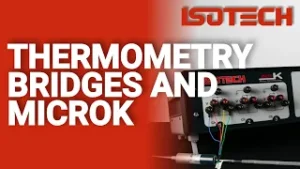Frequently Asked Questions
Discover clear answers to FAQs about temperature calibration and equipment, from SPRTs to Thermocouples, Bridges to Dry Blocks. We break down key terms, equipment, and concepts in clear, beginner-friendly language. Whether you’re new to temperature calibration or looking to build a solid foundation, you’ll find straightforward answers here. From SPRTs and calibration bridges to dry blocks and more, we’re building a comprehensive resource—have a suggestion for something to include? Just let us know, or fill the box below – as we stress on our training course, “There is no such thing as a silly question“.
Click the links to move to the relevant area of your interest:
Quick Definitions
Here are some key temperature calibration terms explained simply. These short definitions help you quickly understand the essentials.
- SPRT – A Standard Platinum Resistance Thermometer used for precise temperature calibration. Defined by the ITS-90 scale.
- Dry Block – A portable device with a heated metal block for calibrating thermometers. Often used in industrial settings.
- Thermometry Bridge – A high-precision instrument used with SPRTs, often in primary temperature laboratories and National Metrology Institutes.
- Reference Resistor – A stable resistor used in bridges to ensure accurate temperature readings by providing a known comparison value.
- Water Triple Point Cell – A high-accuracy temperature reference at 0.01°C where ice, water, and vapor coexist, used to verify thermometer accuracy.
General Questions About Temperature Calibration
Why is temperature calibration important, and is it really necessary?
Yes, it’s necessary. Over time, sensors can drift, leading to errors that impact product quality, safety, and compliance. Regular calibration ensures accurate measurements, maintains confidence in your data, and compliance with standards.
How often should I calibrate my temperature sensors or instruments?
It depends. A one-year interval is common, but ISO 17025 does not specify a fixed period. Instead, it requires that calibration intervals be based on factors like usage, environment, and required accuracy.
A sensor used daily on-site may drift more than one used occasionally in a lab. If a device is found out of spec at its annual check—when did it drift? Last month? Six months ago?
This is why regular checks between calibrations matter:
• Use a water triple point cell as a stable reference
• Or use a dry block, or even an ice point
• Using two probes is a good idea—it allows cross-checks to catch unexpected drift
Annual calibration is good practice—but ongoing verification is what builds real confidence in your measurements.
Understanding SPRTs and Thermometry Bridges
What is a Standard Platinum Resistance Thermometer?
A Standard Platinum Resistance Thermometer, or SPRT, is a highly accurate temperature sensor defined by the ITS-90 scale. It uses the stable electrical resistance of high-purity platinum to provide precise and repeatable temperature measurements. SPRTs are used in national laboratories, calibration facilities, and industries that require ultra-precise temperature control. However, they are delicate instruments and must be handled with care to maintain accuracy.
Watch our video introduction to Standard Platinum Resistance Thermometers (SPRTs)
What is a Thermometry Bridge?
A thermometry bridge is a high-precision instrument used to measure the resistance of temperature sensors, especially Standard Platinum Resistance Thermometers (SPRTs). It operates on a resistance ratio measurement, comparing a known and unknown resistance to determine temperature with exceptional accuracy. Thermometry bridges are vital tools in calibration labs, national metrology institutes, and industries that require precise thermal measurements.
Explore how thermometry bridges work – microK explained (video)
Why Do Thermometry Bridges Need Reference Resistors?
Thermometry bridges don’t measure resistance directly—they measure resistance ratios. Reference resistors provide a stable, known value that allows the bridge to accurately determine the resistance of a temperature sensor. Using ultra-stable resistors ensures low uncertainty and long-term stability, which is why calibration labs rely on them instead of standard thermometer readouts.
Temperature Calibration Equipment Explained
What is a Dry Block?
A dry block calibrator, or metal block bath – often referred to simply as a dry block, is a portable device used to calibrate temperature sensors. It features a metal block that is electrically heated or cooled to a precise temperature. The sensor under test is inserted into the block, typically via a removable insert to suit different size blocks. They can typically span a temperature range from -100°C to 1200°C.
See How to use a Dry Block Bath for Temperature Calibration – 3-minute video guide
What is a Stirred Liquid Bath?
A stirred liquid bath—also known as an oil bath or calibration bath—is a precision temperature calibration device commonly used in laboratories. It contains a fluid, such as silicone oil or alcohol, within an insulated tank, with active stirring to ensure excellent temperature uniformity. The bath is electrically heated or cooled, and test sensors are immersed directly into the liquid to achieve thermal equilibrium. Models typically cover temperature ranges from -80°C to 300°C. Compared to dry blocks, stirred liquid baths offer superior thermal performance and greater immersion depth.
See how stirred liquid baths work for calibration in our 10-minute video guide
What is a Water Triple Point Cell?
A Water Triple Point Cell is a high-precision calibration device that provides a stable reference at 0.01°C, the temperature where ice, liquid water, and vapor coexist in equilibrium. It’s commonly used to verify and calibrate Standard Platinum Resistance Thermometers (SPRTs) and is essential in laboratories working to the ITS-90 scale. Its stability and reproducibility make it ideal for checking thermometer accuracy between full calibrations.
Understand the Water Triple Point Cell – 0.01°C reference explained (video)
What is an ITS-90 Fixed Point Cell?
An ITS-90 Fixed Point Cell is a temperature calibration device that provides a stable, reproducible reference point based on the melting, freezing, or triple point of a pure substance—such as indium, tin, zinc, or aluminum. These cells are defined by the International Temperature Scale of 1990 (ITS-90) and are used to calibrate Standard Platinum Resistance Thermometers (SPRTs) with extremely low uncertainty.









